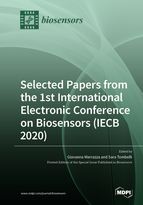Selected Papers from the 1st International Electronic Conference on Biosensors (IECB 2020)
A special issue of Biosensors (ISSN 2079-6374).
Deadline for manuscript submissions: closed (30 April 2021) | Viewed by 77453
Special Issue Editors
Interests: immobilization procedure of biomolecules; protein–DNA complexes; aptamer; enzymatic sensors; thick-film technology; nanodispensing technologies; micro-flow systems; carbon nanotubes; nanoparticles; nanocomposite polymers; molecular imprinted polymers; protein-polymer conjugates
Special Issues, Collections and Topics in MDPI journals
Interests: biosensors; optical sensors; point-of-care devices; intracellular sensing; immunoassays; aptamers; molecularly imprinted polymers
Special Issues, Collections and Topics in MDPI journals
Special Issue Information
Dear Colleagues,
The 1st International Electronic Conference on Biosensors (IECB 2020) will be held from 2 to 17 November 2020 (https://sciforum.net/conference/IECB2020), verifying the great interest of the related community in this Conference Series. The e-conference will be hosted on sciforum.net, an online platform developed by MDPI for scholarly exchange and collaboration.
During the event, a large number of excellent contributions covering key areas of opportunity and challenge will be presented. More specifically, the following areas will be covered:
- Technologies for innovative biosensors
- Bioengineered and biomimetic receptors
- Microfluidics for biosensing
- Biosensors for emergency situations
- Nanotechnologies and nanomaterials for biosensors
- Intra- and extra-cellular biosensing
- Advances applications in clinical, environmental, food safety, and cultural heritage fields
- Biosensors for pathogens
- Posters
This Special Issue welcomes selected papers from the IECB 2020 that promote and advance the exciting and rapidly changing field.
Submitted contributions will be subjected to peer review and—upon acceptance—will be published with the aim of rapidly and widely disseminating research results, developments, and applications.
It should be noted that submitted manuscripts should have at least 50% additional, new, and unpublished material as compared to the IECB 2020 published paper.
We look forward to receiving your contributions.
Dr. Giovanna Marrazza
Dr. Sara Tombelli
Guest Editors
Manuscript Submission Information
Manuscripts should be submitted online at www.mdpi.com by registering and logging in to this website. Once you are registered, click here to go to the submission form. Manuscripts can be submitted until the deadline. All submissions that pass pre-check are peer-reviewed. Accepted papers will be published continuously in the journal (as soon as accepted) and will be listed together on the special issue website. Research articles, review articles as well as short communications are invited. For planned papers, a title and short abstract (about 100 words) can be sent to the Editorial Office for announcement on this website.
Submitted manuscripts should not have been published previously, nor be under consideration for publication elsewhere (except conference proceedings papers). All manuscripts are thoroughly refereed through a single-blind peer-review process. A guide for authors and other relevant information for submission of manuscripts is available on the Instructions for Authors page. Biosensors is an international peer-reviewed open access monthly journal published by MDPI.
Please visit the Instructions for Authors page before submitting a manuscript. The Article Processing Charge (APC) for publication in this open access journal is 2700 CHF (Swiss Francs). Submitted papers should be well formatted and use good English. Authors may use MDPI's English editing service prior to publication or during author revisions.








